| Author |
Message |
|
Jeroen Averhals
|
 Posted: Tue 22 Mar, 2011 3:01 am Post subject: Sword ID Posted: Tue 22 Mar, 2011 3:01 am Post subject: Sword ID |
 |
|
Hello,
I have bought three swords at an arms fair in Belgium.
I would some more information on them.
The first seems a Walloon sword.
weight 837g, length 80.5 cm, POB 4 cm
The Walloon has some markings on the blade which are impossible to photograph. from guard to tip
Some kind of renaissance jester holding a straight sword, PARISTRO IS (very hard to read, possibly wrong), five stars
*
***
*
an arm coming out a cloud holding a curved sword, SOLIDEO GLORIA, between those some plants
other side: jester holding a bow, unreadable inscription H----RTI I, four square points above two stars
.
. .
.
* *
an arm coming out of a cloud holding a straight sword and un unreadable latin inscription ----ESLI ----VIDE
The second a sidesword.
weight 1175g, length 96 cm, POB 15 cm
no markings on this blade.
The third a hand and a half sword with complex hilt.
weight 1331g, length 126 cm, POB 14 cm
It is to long to be used with one hand, but the grip length is only 15.5 cm. I have normal hands an the grip is far to small to be held with two hands. Only the true side of the sword is sharpened and the top 5cm of the false side. The false side is blunt, like a very blunt saber, impossible to cut with.
There are no markings on the blade.
The grip is wood, with spiraling cord, covered with leather. On the leather used to be spiraling cord or metal, but that is missing.
I would like to know if anyone thinks they are (Victorian or modern) fakes.
Also the datings and origin.
Thanks for looking and helping.
Jeroen Averhals
 Attachment: 56.35 KB Attachment: 56.35 KB

close up of hand an haff hilt
 Attachment: 45.05 KB Attachment: 45.05 KB

hand and a half sword
 Attachment: 45.2 KB Attachment: 45.2 KB

sidesword
 Attachment: 52.18 KB Attachment: 52.18 KB
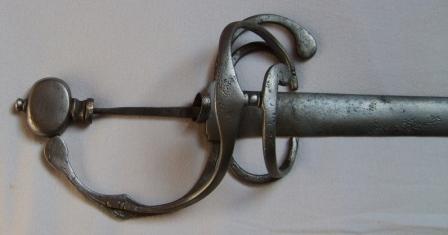
close up of sidesword hilt
 Attachment: 54.68 KB Attachment: 54.68 KB
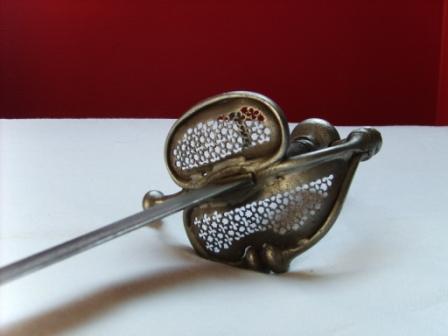
close up of walloon basket
 Attachment: 45.64 KB Attachment: 45.64 KB

walloon sword
 Attachment: 49.6 KB Attachment: 49.6 KB

three swords
 Attachment: 56.02 KB Attachment: 56.02 KB
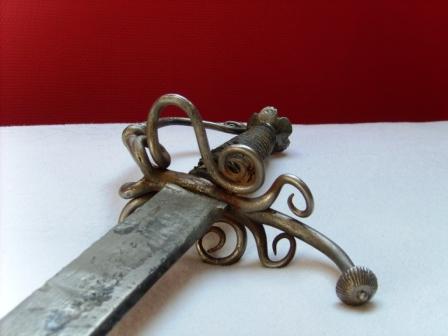
close up of hilt of hand and a half sword
Vigor et Veritas
|
|
  |
 |
|
Jeroen Averhals
|
 Posted: Fri 25 Mar, 2011 10:55 am Post subject: Posted: Fri 25 Mar, 2011 10:55 am Post subject: |
 |
|
I have checked some books I have and only found some other Walloon swords. But all of these seem to have some differences with the one I have.
The back of the guard is straight, where all of the Waloon swords have curled guards. The pommel is peened without a pommel cap. The side/knuckle bar is not peened to the pommel, there is a hole in the pommel where the bar fits in.
Does any one has an idea what this could mean?
Of the sidesword and hand and a halfsword I have found absolutely nothing in my books. Though the sidesword seems very common and the hand and a halfsword has a very special design. It somewhat reminds me of a Swiss saber.
If anyone would need pictures of some parts I can make them.
Thanks
Jeroen Averhals
Vigor et Veritas
|
|
  |
 |
Sean Flynt

|
 Posted: Fri 25 Mar, 2011 11:45 am Post subject: Posted: Fri 25 Mar, 2011 11:45 am Post subject: |
 |
|
Once again, I'm left wanting a copy of AVB Norman's book.  I'm hoping somebody else can shed some light on this. E.B. Erickson could, I'm sure. I'm hoping somebody else can shed some light on this. E.B. Erickson could, I'm sure.
I'd love to see a different angle on that "sidesword" (maybe a shot like the one below) so we can better see the construction and arrangement of the bars. It bears a resemblance to the field swords of ca. 1600, but apparently without any bars on the reverse. Is there any evidence of removed bars on the reverse?
This is a very interesting form to me, if genuine, because I've wondered if I could remove the poorly executed reverse bars of a reproduction field sword of ca. 1610 and still have something historically plausible.
The sword shown below is one of the famous Stantler field swords. If you were to remove the reverse bars and eliminate the ricasso you'd see more resemblance to your sword. If yours is genuine I think I'd date it to roughly the same period and to Northern Europe.
 Attachment: 74.33 KB Attachment: 74.33 KB
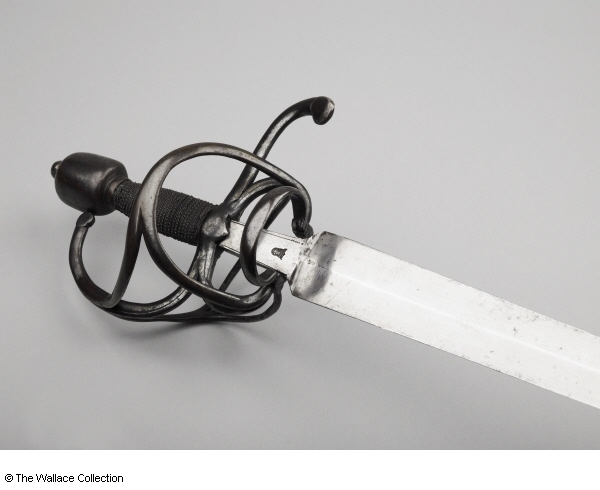
-Sean
Author of the Little Hammer novel
https://www.amazon.com/Little-Hammer-Sean-Flynt/dp/B08XN7HZ82/ref=sr_1_1?dchild=1&keywords=little+hammer+book&qid=1627482034&sr=8-1
|
|
   |
 |
|
Jeroen Averhals
|
 Posted: Mon 28 Mar, 2011 9:24 am Post subject: Posted: Mon 28 Mar, 2011 9:24 am Post subject: |
 |
|
Sean,
I have made some more pictures. Please see below.
There is no evidence of removed bars on the reverse side.
A question for the blacksmiths, what are those parallel lines in the middle of the knuckle bar?
Does it say something on the way it was made or on the sort of metal used?
thanks,
Jeroen
 Attachment: 66.14 KB Attachment: 66.14 KB
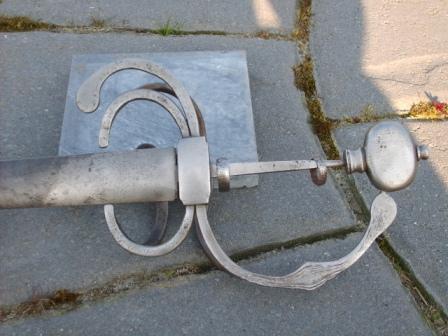
 Attachment: 72.51 KB Attachment: 72.51 KB
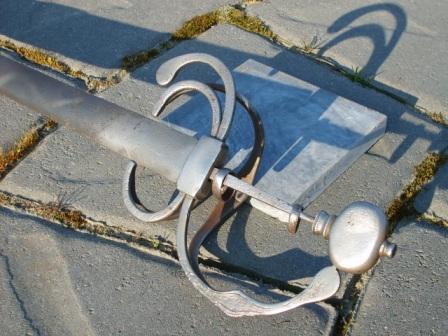
 Attachment: 71.56 KB Attachment: 71.56 KB
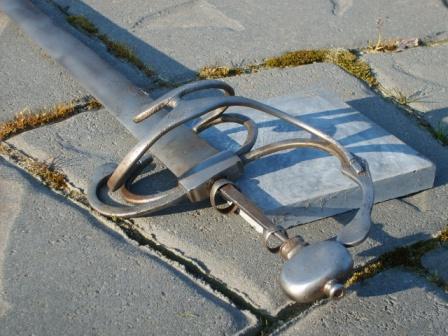
 Attachment: 72.55 KB Attachment: 72.55 KB
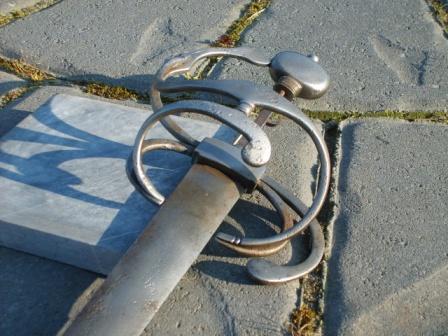
Vigor et Veritas
|
|
  |
 |
|
Don Stanko
|
 Posted: Mon 28 Mar, 2011 6:35 pm Post subject: Posted: Mon 28 Mar, 2011 6:35 pm Post subject: |
 |
|
|
I think the one missing the handle is Victorian. It was common practice to create a sword which could be hung neatly on a wall for decoration. That could explain why one side was so complex and the other side had nothing. Also, something about the blade seems off, almost unfinished. Just a guess without being able to see it in person.
|
|
  |
 |
Sean Flynt

|
|
   |
 |
Jack W. Englund

|
 Posted: Tue 29 Mar, 2011 2:49 pm Post subject: Posted: Tue 29 Mar, 2011 2:49 pm Post subject: |
 |
|
| Sean Flynt wrote: | | The sword shown below is one of the famous Stantler field swords.. |
Just a ??
Were these swords ever known to be used in the UK ?? ( perhaps on the "Borders" )
Jack
|
|
  |
 |
Sean Flynt

|
 Posted: Tue 29 Mar, 2011 3:02 pm Post subject: Posted: Tue 29 Mar, 2011 3:02 pm Post subject: |
 |
|
| Jack W. Englund wrote: | [Just a ??
Were these swords ever known to be used in the UK ?? ( perhaps on the "Borders" )
Jack |
All of the examples I've seen have been identified as being made for the Munich town watch. So many of them have been deaccessioned from one museum and bought by another that they can be found worldwide, which muddies the waters a bit.
Having said that, the Borderers imported German arms and armour--including complex-hilt swords--and there's no reason this very practical design could not have found its way there, if not via Stantler then via some other enterprising German smith. The bigger issue is that the Stantler swords date to ca. 1600, after the heyday of the Rievers. This exact design doesn't appear much before then, as far as I can tell, but, again, it's just a complex hilt on an arming sword blade and those were common in the Riever period. I think something like this would make a nice sidearm for a headman.
-Sean
Author of the Little Hammer novel
https://www.amazon.com/Little-Hammer-Sean-Flynt/dp/B08XN7HZ82/ref=sr_1_1?dchild=1&keywords=little+hammer+book&qid=1627482034&sr=8-1
|
|
   |
 |
Jack W. Englund

|
 Posted: Wed 30 Mar, 2011 8:51 am Post subject: Posted: Wed 30 Mar, 2011 8:51 am Post subject: |
 |
|
Thank You Sean.
Jack
|
|
  |
 |
|
|

